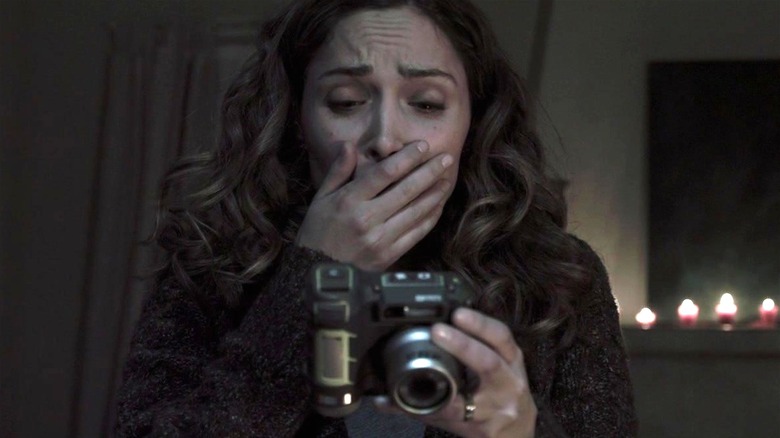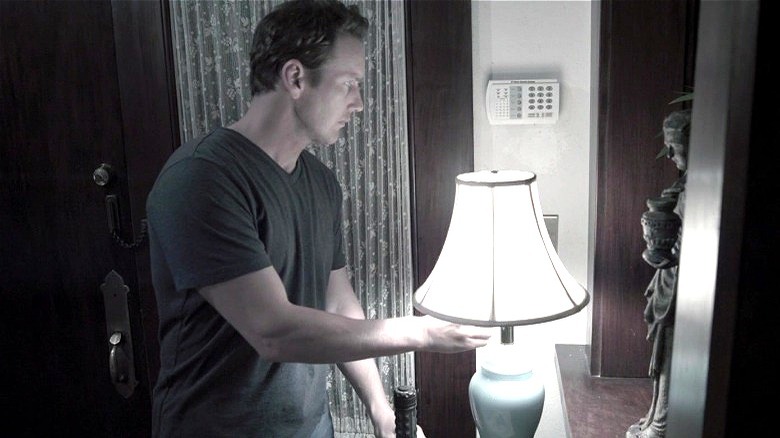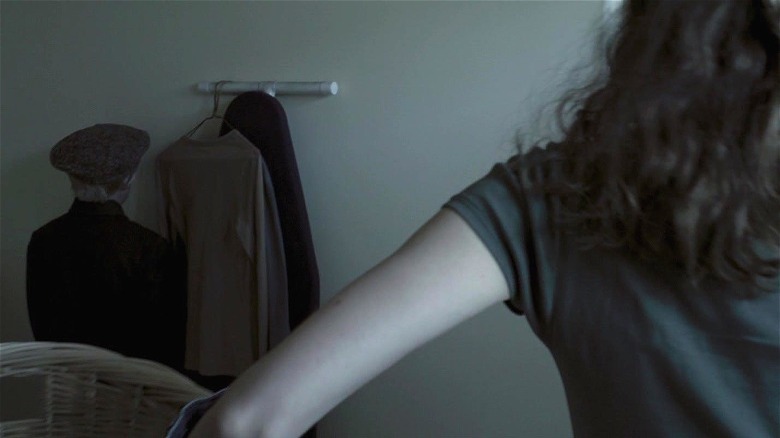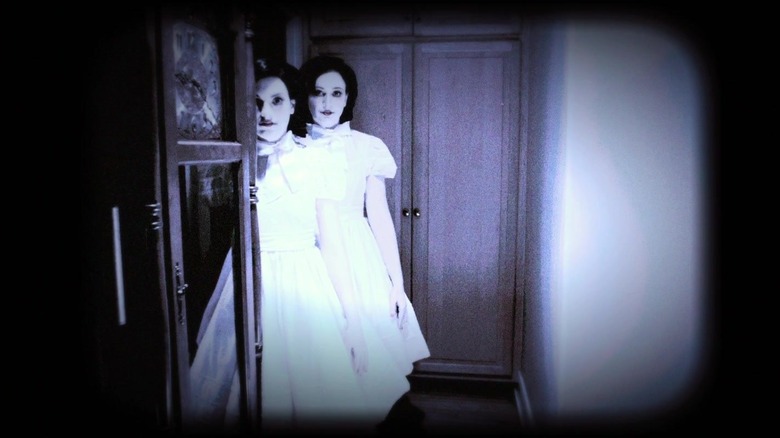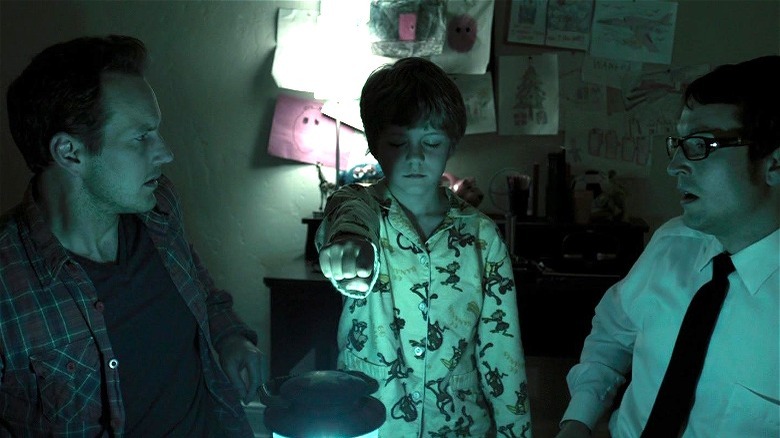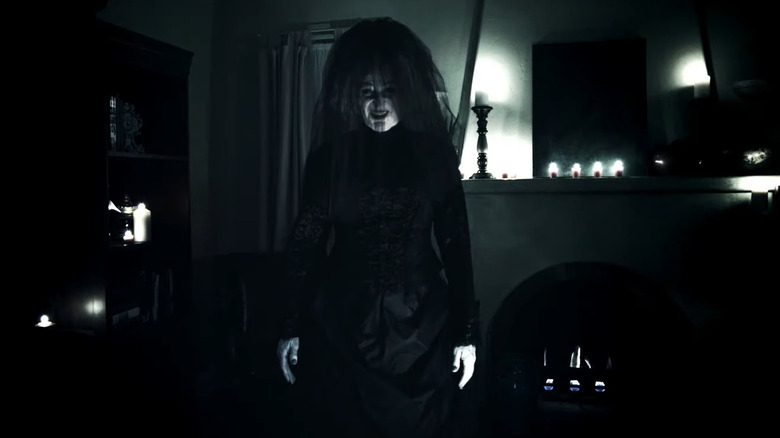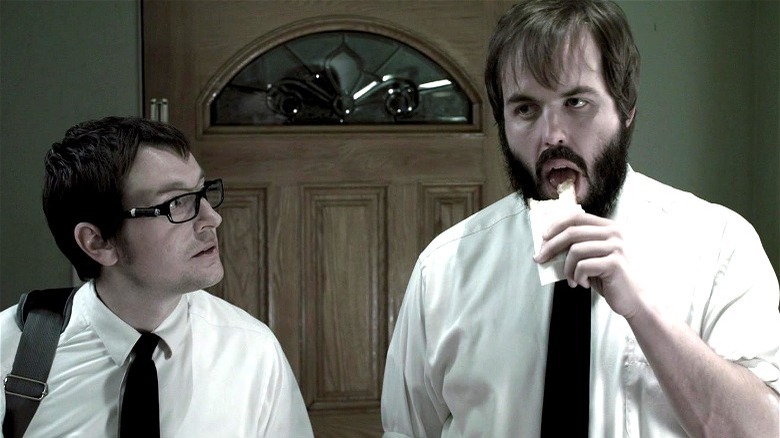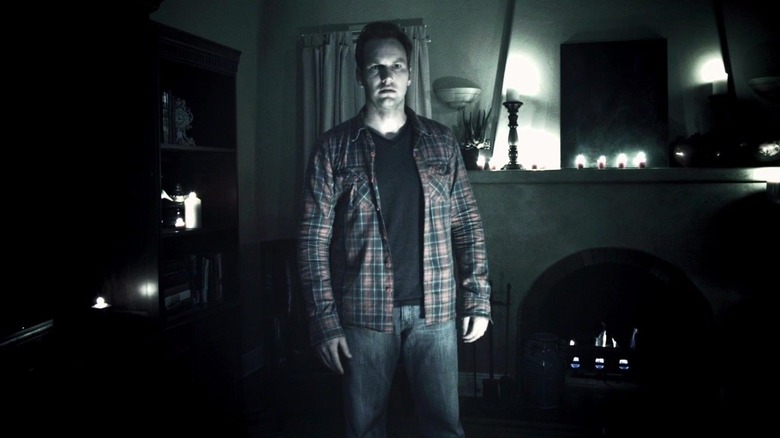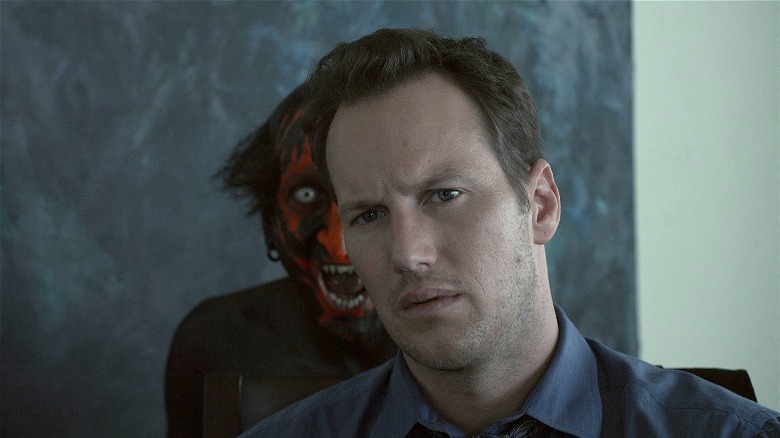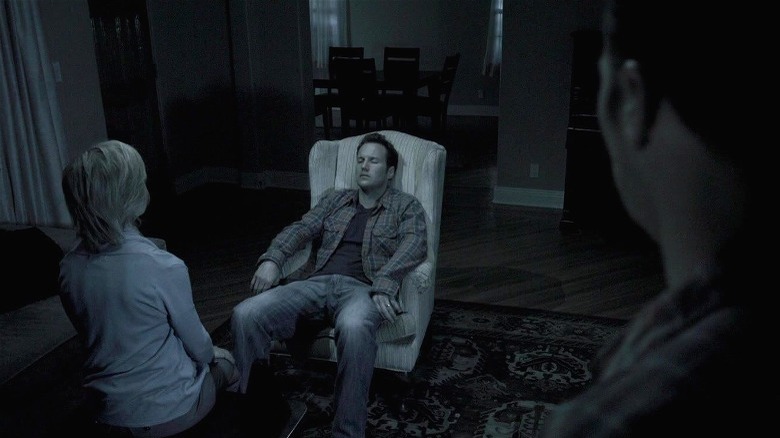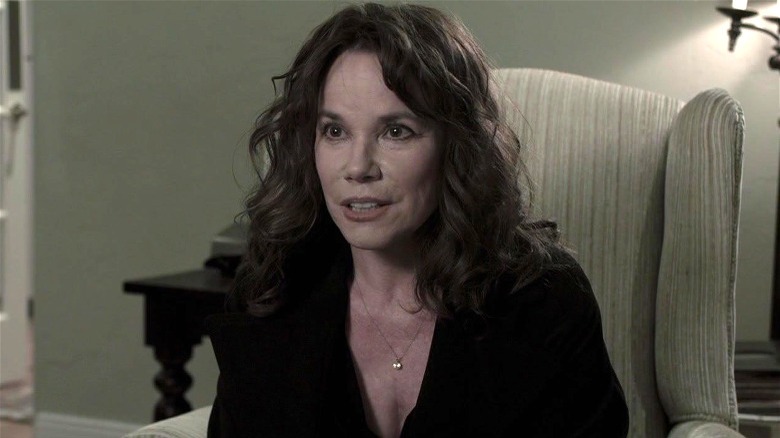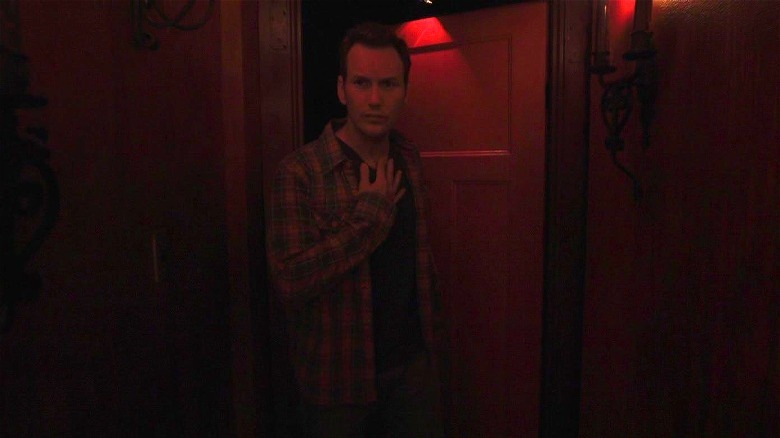Things That Happen In Every Insidious Movie
From James Wan and Leigh Whannell (the team that gave the world "Saw"), the "Insidious" saga began as a little horror movie with a creative twist that bloomed into a franchise. Initially chronicling the Lambert family and their confrontation with the supernatural, the series transitioned into a story about Elise Rainier (played by the always fantastic Lin Shaye), a medium protecting people from evil, at great cost to herself.
While the first two films ("Insidious" and "Insidious: Chapter 2") essentially tell one complete story, "Insidious: Chapter 3" and "Insidious: The Last Key" mostly stand on their own. With a continuing storyline that folds in on itself ("Chapter 3" and "The Last Key" are prequels), there are several elements that carry over to each installment. Today, we'll be taking a look at these things in order to discuss their greater context and the themes they carry with them.
Obviously, things like ghosts and demons or people reaching out to Elise for help won't be listed here. These things are baked into the very concept of the series. Therefore they would only be worth mentioning if they didn't happen. Instead, we'll be looking at running gags, references, and details that remain constant outside of the initial concept. Without further ado, these are things that happen in every "Insidious" movie.
Flickering lights
There's probably a good explanation for why lights in these movies always seem to go haywire whenever ghosts are around. On the one hand, it's a scary movie. The darker the scene, the spookier it gets. On the other hand, there could be a more pseudo-scientific answer. Perhaps the spirits need electricity in order to manifest enough strength to carry out their wicked schemes.
Regardless, it's a constant in the franchise. Listing every instance in which it occurs would take forever, but suffice it to say, it tends to happen whenever a scene gets super intense. For example, take the seance in the first film. When Elise begins communicating with the demon feeding on Dalton (Ty Simpkins), everything gets a little crazy, including the lights. It certainly makes for an effectively creepy scene.
The one possible exception to this is "The Last Key." There are plenty of ghosts in the film but not a ton of flickering lights — not unless you count the opening. In the film's first scene, we're taken back to Elise's childhood, where she's living next to a prison that carries out the death penalty. When the lights flicker, Elise's brother excitedly points out that someone must be getting the electric chair tonight. Is that really what caused the lights to go out? Or was it the presence of the little boy ghost hiding in Elise's bedroom? Or the demon controlling her abusive father?
Unseen entities
Whenever you watch a movie about the supernatural, there's bound to be a scene where a ghost runs by in the background whenever the main characters aren't looking. When done well, these scenes can turn the viewer's blood to ice. Similar to the hidden ghosts in "The Haunting of Hill House," the "Insidious" movies take this trope to the next level by making the reveals so subtle that even the audience isn't sure of what they saw.
Perhaps the best example is in the original film. While Renai (Rose Byrne) handles some chores around the house, she passes through the laundry room. Unbeknownst to her, a little boy we've never seen before is standing with his face to the wall. There's no musical sting to alert the audience to its presence, the boy is just part of the scenery. A similar moment happens in "Insidious: Chapter 2" as Renai talks on the phone and walks by an empty room ... well, empty aside from the ghost of Michelle Crane (Danielle Bisutti).
These moments are more traditional in "Chapter 3" and "The Last Key" and aren't treated with the same matter-of-factness of the first two films. However, these hidden spirits make the "Insidious" movies special: The ghosts are depicted as having a real physical presence. They aren't ethereal beings disappearing in clouds of smoke. They share the space with the living characters, making them feel more substantial than in other haunted house movies.
Equipment POV
In the first "Insidious" film, in order to find out if their house is haunted, the Lamberts contact Elise and her crew to come by and investigate. Tucker the tech guy (Angus Sampson) brings all kinds of gnarly, handmade ghost hunting equipment with him. He goes through the house taking readings and getting nowhere until he uses the camera/viewfinder he fashioned into a ghost-detecting tool. From his point of view, we see every picture he takes under a different filter. In one of the most startling scenes of the film, he takes a snapshot and sees two women looking at him from behind a grandfather clock.
The sequels then weave in a borderline found-footage element (perhaps an influence from producer and "Paranormal Activity" director Oren Peli) with entire sequences seen through the eyes of a camera lens. This is most noticeable in "Chapter 2," but it continues on through the following installments as well. For example, in "Chapter 3," there's a scene where Quinn (Stefanie Scott) has a camera strapped to her forehead to see if anything happens while she sleeps. We then see a monitor showing the POV of the camera that has somehow been hidden in her closet when she seemingly disappears.
"The Last Key" has a similar scene where Elise walks through her old home and doesn't notice a pair of feet standing on the table. While sometimes these moments can feel intrusive, for the most part, they're successful in putting the audience in the shoes of the characters.
Communing with the dead
"Insidious" takes a common haunted house trope — the seance — and twists it just enough to make it feel new again. The first film sees Elise covering her head in a gasmask with a tube connected to headphones, which Specs (Leigh Whannell) wears so he can listen and write down her conversation with the entity haunting Dalton. It's a weird and frankly cool scene that leaves quite the impression on terrified audiences.
"Chapter 2" also gets creative when Elise's old friend, Carl (Steve Coulter), uses his dice with letters on them to speak with the dead. At first, it looks like he's unable to make contact. Then, the dice start forming words in response to his questions. But in a nice little twist, when they visit the home of Parker Crane (Tom Fitzgerald), he realizes the dice are misleading him, and he is no longer talking to Elise.
In "Chapter 3," Elise just kind of calls out to the spirits. It's not as dramatic as the other moments, but it gets the job done. "The Last Key" introduces a whistle Elise's little brother is supposed to use whenever he gets scared. He loses it, but Elise finds it again when she returns to the house to investigate. One of the ghosts in the house uses the whistle to answer Elise's question, giving us a scene that's quite engaging as it allows Elise to walk around and listen for the whistle.
Trouble breathing
Most of the ghosts in "Insidious" aren't seeking help completing their unfinished business. This isn't like "The Sixth Sense" or "Stir of Echoes," where all the protagonists need to do is help the spirits move on by comforting them or solving their murder. Many of the entities in these films (some of whom are literal demons) actively want to hurt the living. One way they do this is by strangling them.
The final scene of "Insidious" features Elise being murdered by the entity that has entered the body of Josh (Patrick Wilson). We learn in the sequel that this being is actually the spirit of a serial killer who needs to murder the rest of Josh's family in order to remain in his body without it decomposing. So, there's another scene in the third act of "Insidious 2" where Josh overpowers someone and attempts to squeeze the life out of them.
In "Chapter 3," the spirit haunting Quinn is an old man in a hospital gown with a breathing apparatus stuck to his face. He's literally referred to as "the man who can't breathe" (Michael Reid MacKay). In the end, his mask is removed, and he struggles for air (even though he's a ghost). There's no strangulation or characters defined by their inability to breathe in "The Last Key," but a ghost does use a rope to hang Elise's mother. This sort of thing happens with such regularity in the films that one can't help but wonder if Leigh Whannell (who wrote all four) has a phobia.
Tucker eats
Elise doesn't work alone — she has the help of her sidekicks, Specs and Tucker. Each of them has quirky characteristics that make them fun characters to have around. Neither are great at dealing with people, though Specs is slightly more adept than his counterpart. Specs is an avid collector of nerdy things and often gets distracted by toys and comics, while Tucker eats.
Whenever Tucker meets a new client, he's chowing down on something. The first time they appear on camera in "Insidious," Tucker is more interested in his Hot Pocket than he is talking to Renai and Josh. When Carl enters act two of "Chapter 2," Tucker is eating a donut. We learn in "Chapter 3" that Specs and Tucker were internet ghost hunters before they met Elise, and when it's suggested she bring them in, we see that Tucker is eating a cupcake, and he doesn't want to speak before he finishes it.
In the prequel film "The Last Key," Elise and the boys travel to her old house to investigate some disturbances the current resident is experiencing. Before they knock on the door, Elise tells Specs and Tucker she has a change of clothes for them. This is the first time they put on shirts and ties to work, and while this makes them look slightly more professional, when the resident opens the door, Tucker is eating an ice cream sandwich.
Mistaken identities
A common theme within all of the "Insidious" movies is that the dead and other spiritual entities will try to deceive you. During the first film, Josh learns that he used to astral project (his soul left his body) when he was a child, just like his son is doing now. When someone does this, it leaves their body open for spirits and demons to possess it, and that's exactly what happened to poor Josh.
As it turns out, Josh used to be stalked by the ghost of an old woman dressed in black (Philip Friedman). She tried to befriend him and manipulate him to leave his body so she could steal it and live again. When Josh enters the Further (where the spirits live) to save his son, the old woman returns and invades his body. When he wakes up, everyone assumes he's who he appears to be. However, a picture reveals the truth. The entirety of the second film is about proving that Josh is possessed. Similarly, there's also the eerie moment in the sequel when Carl discovers he isn't actually talking to Elise's spirit.
There are two instances of mistaken identity in "Chapter 3." First, Quinn thinks the spirit she's reaching out to is her mother. However, it's actually the man who can't breathe trying to lure her into the Further to live with him forever. In "The Last Key," one of Elise's nieces (Spencer Locke) follows her father's voice, only to meet the demon dwelling in the basement. In short, when dealing with a haunting, be absolutely sure who you're talking to.
Energy draining
A major theme in the "Insidious" films is that life overpowers death. We all fall victim to time eventually, but while we're alive, we're more powerful than the dead. This is why so many of the entities Elise battles try to drain the life out of us, so we are weak enough for them to achieve their goal.
With Dalton, the Lipstick-Face Demon (Joseph Bishara) needs to keep him away from his body long enough that he is too weak to stop him from possessing it for itself. Parker Crane, the spirit inhabiting Josh in "Chapter 2," is at risk of returning to the Further because Josh's body is starting to decay. As a result, Parker needs to kill the rest of the Lamberts in order to be strong enough to remain in the realm of the living. In "Chapter 3," the man who can't breathe is able to claim half of Quinn's soul, but he needs her to be weaker to take the other half.
The KeyFace Demon (Javier Botet) in "The Last Key" is a little different. The way he drains life from his victims is by controlling them. He gets inside their heads and forces them to do terrible things, like Elise's father (Josh Stewart) abusing her and murdering women in the basement. However, he does want to drain Elise of her power so that he's able to open all the red doors in the Further to go on hurting more people.
Waking up in the Further
When dealing with ghosts, you're going to have to address certain beliefs about the afterlife. The "Insidious" movies are pretty good about staying away from concepts like Heaven and Hell, leaving that part of things open to the viewer's interpretation. However, they deal pretty heavily with a realm similar to that of limbo. Elise explains that there's a realm beyond our own that she refers to as the Further. It's a place for lost spirits and demons but not the living.
Whenever Dalton astral projects, his soul travels through the Further. The same is true of Josh. When Josh agrees to go looking for his son, we see Elise hypnotize him to sleep. When he wakes up, he's in the Further. But eventually, the Further almost becomes like Freddy Krueger's dream realm. Characters start waking up there left and right. For example, after Carl is strangled by Parker Crane (in Josh's body) in "Chapter 2," he wakes up in the Further.
This makes sense because he's practically dead, but in "Chapter 3" and "The Last Key," Elise wakes up there like it's nothing. She's mentioned that she's been there before, but the movies never addressed that passing into this realm was so easy before. Every time it happens, the films treat it like a big deal, but after a while, you wonder why everyone can't just fall asleep and wake up in the Further.
Family drama
By design, haunted house movies usually deal with a past that people don't like talking about. Oftentimes, these dark secrets involve family history. However, with the existence of the paranormal, the past never stays dead, and dormant secrets tend to rise again. This, to varying degrees, is certainly true with the "Insidious" franchise. Josh learns that aspects of his childhood (the scary stuff) were hidden from him for his protection. We see that Parker Crane was abused by his mom. Elise discovers that her father wasn't responsible for all the horrific things he did, but it was the work of a demon tormenting him and controlling him for decades. And Quinn and her dad are constantly at odds because she thinks (incorrectly) that he doesn't care about her deceased mother. In other words, in the "Insidious" franchise, characters should just be honest about their histories and stop trying to cover stuff up so much. It would prevent a whole lot of haunted headaches.
Into the Further to save a life
Every chapter in the "Insidious" saga concludes with someone venturing into the Further to save someone's life. In the first film, Josh does so to find Dalton and bring him home. Both Elise (whose already dead) and Carl (whose only mostly dead) help Josh (who's been trapped there the entire time) escape the Further in "Chapter 2." With "Chapter 3," Elise ventures into the Further and meets the entity disguised as her husband in order to pull Quinn away from the man who can't breathe. And in "The Last Key," Elise's niece is taken to the Further by KeyFace.
Granted, in some films, the Further is sometimes scarier than others. But the terror isn't what really what matters here. Instead, what matters is the message. By choosing to end each movie with human characters entering a world they have no business existing in, the filmmakers are telling us time and time again that the people who love us are willing to do anything to keep us safe. No matter how hopeless things get, there are those who will walk through the darkness for us.
